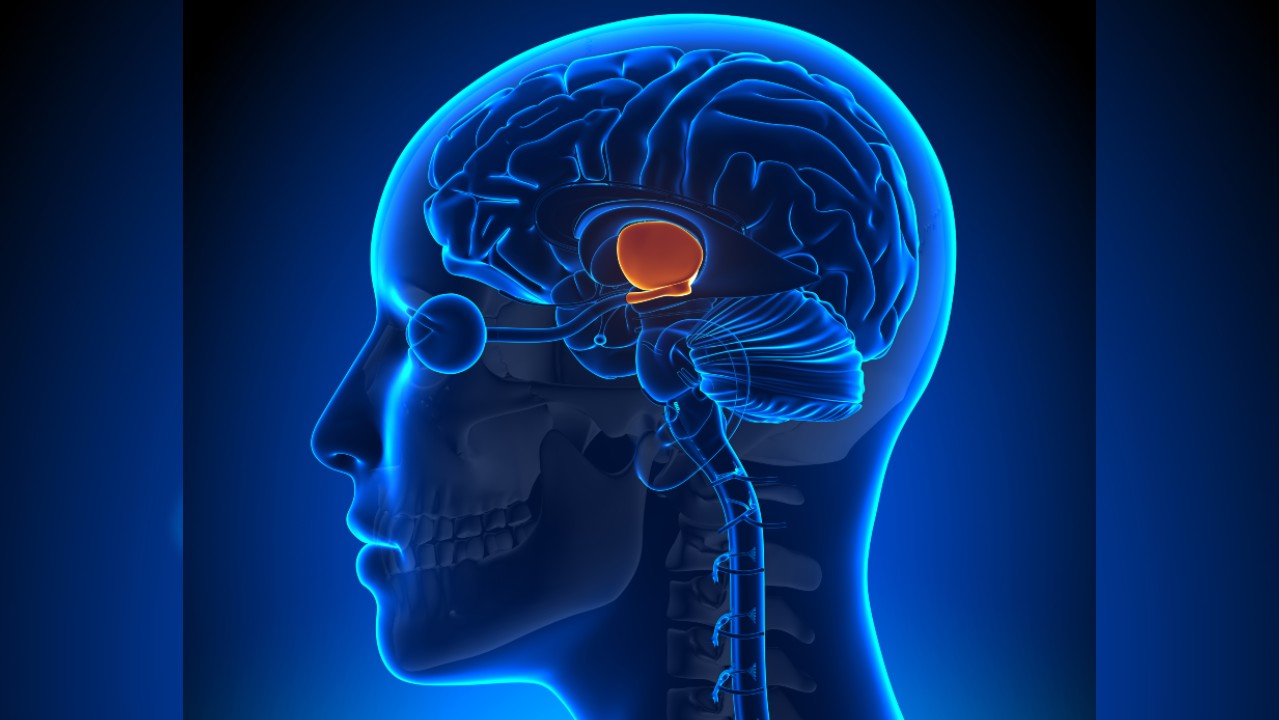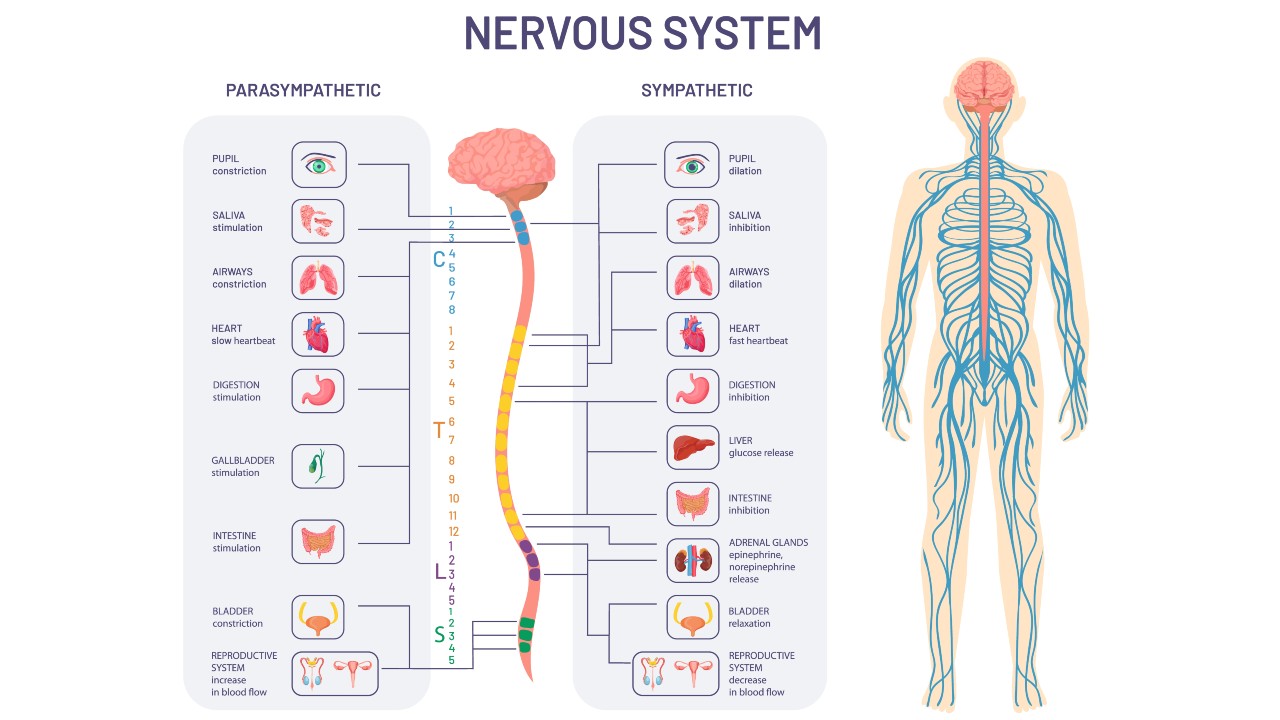what part of the nervous system causes your heart to race
Fight or flight: The sympathetic nervous system

When faced with imminent physical danger, the human body'south sympathetic nervous system triggers our "fight-or-flight" response. The sympathetic nervous organization is a normally harmonized network of brain structures, fretfulness and hormones that, if thrown off residual, tin effect in serious complications.
What is a sympathetic nervous arrangement?
The sympathetic nervous system makes upwards role of the autonomic nervous arrangement, also known every bit the involuntary nervous system. Without witting direction, the autonomic nervous organisation regulates important bodily functions such every bit middle rate, blood pressure, pupil dilation, body temperature, sweating and digestion, co-ordinate to a review in the American Journal of Pharmaceutical Pedagogy (opens in new tab). Enquiry suggests that distinct types of nerve cells, called neurons, command these different physical reactions by directing the action of skeletal muscle, cardiac muscle and gland secretion. The organisation allows animals to make quick internal adjustments and react without having to retrieve nearly it.
The sympathetic nervous system directs the trunk's rapid involuntary response to unsafe or stressful situations. A flash flood of hormones boosts the torso's alertness and middle rate, sending extra blood to the muscles. Breathing quickens, delivering fresh oxygen to the brain, and an infusion of glucose is shot into the bloodstream for a quick free energy heave. This response occurs so rapidly that people frequently don't realize it'due south taken place, according to Harvard Medical Schoolhouse (opens in new tab). For instance, a person may jump from the path of a falling tree earlier they fully annals that it'due south toppling toward them.
The sympathetic nervous system doesn't destress the torso once the tree is felled or the danger has passed. Some other component of the autonomic nervous system, the parasympathetic nervous arrangement, works to calm the body down, according to the Clinical Anatomy of the Cranial Nerves, published in 2014 by Academic Printing. To counter the fight-or-flight response, this organization encourages the trunk to "rest and digest." Blood pressure, breathing rate and hormone menses return to normal levels as the body settles into homeostasis, or equilibrium, once more.
The sympathetic and parasympathetic nervous systems work together to maintain this baseline and normal body role.
How is the sympathetic nervous system organised?
Structures in the brain, spinal cord and peripheral nervous organization support the office of the sympathetic nervous system, according to a 2016 review in the journal BJA Educational activity (opens in new tab). Receptors in internal organs of the breast and abdomen collect information from the torso and transport it up to the encephalon through the spinal cord and cranial fretfulness. The hypothalamus, a brain structure important for regulating homeostasis, receives signals from the body and tunes the activity of the autonomic nervous organisation in response.
This brain structure also gathers information from areas higher in the brain, such every bit the amygdala, according to a review in the journal Biological Psychiatry (opens in new tab). Often chosen the emotional brain, the amygdala pings the hypothalamus in times of stress.

The hypothalamus so relays the alert to the sympathetic nervous system and the point continues on to the adrenal glands, which then produce epinephrine, better known as adrenaline. This hormone triggers the profuse sweating, rapid heartbeat and brusk breaths nosotros associate with stress. If the danger persists, the hypothalamus sends a new message through the nerve organisation grapevine, instructing the adrenal glands to produce the hormone cortisol to keep the stress response rolling.

Outgoing commands from the sympathetic nervous system exit the spinal cord in the thoracolumbar region, or the mid to lower spine. Sympathetic neurons exit the spinal cord and extend in ii columns on either side of information technology. These neurons then tag a second set up of nerve cells into the relay, signaling them with aid from the chemical messenger acetylcholine.
Having picked upwardly the billy, the 2d set of neurons extends to polish muscles that execute involuntary muscle movements, cardiac muscles and glands across the body. Often, the parasympathetic nervous system communicates with the same organs as the sympathetic nervous system to go along the activity of those organs in check.
What happens when it doesn't work?
The sympathetic and parasympathetic nervous systems balance on either side of a wobbling scale; each system remains active in the torso and helps annul the actions of the other. If the opposing forces are generally balanced, the body achieves homeostasis and operations chug along as usual. But diseases can disrupt the balance.
The sympathetic nervous system becomes overactive in a number of diseases, according to a review in the periodical Autonomic Neuroscience (opens in new tab). These include cardiovascular diseases like ischemic centre disease, chronic heart failure and hypertension. A heave of sympathetic signaling raises the blood pressure and enhances tone in shine muscles, which may cause hypertension.

Beyond cardiovascular ailments, sympathetic dysfunction has been associated with kidney disease, type II diabetes, obesity, metabolic syndrome and even Parkinson's disease.
"Anybody thinks near Parkinson's affliction in terms of its motor symptoms, but these autonomic symptoms really announced long earlier," said Dr. Marina Emborg, director of the Preclinical Parkinson'south Research Programme at the Academy of Wisconsin-Madison. Changes in sympathetic nervous activity are evident in the pare, pupils and specially the heart.
"Some patients [with Parkinson'southward] draw that they are more tired or have fatigue, but really, problems in the heart contribute to these overall symptoms," Emborg told Alive Science.
Parkinson'south damages the sympathetic neurons that help maintain levels of epinephrine and norepinephrine in the body — chemicals that tell the centre when to pump harder, such as when yous movement to stand up or exercise. Damage to these neurons can result in a lack of blood menstruation in patients with Parkinson'south, so they often experience airheaded upon continuing, which dramatically increases their risk of falls.
Sympathetic dysfunction as well underlies mental wellness weather condition such as feet, depression and chronic stress, an article in Forbes reported. In short bursts, the body's physical stress response can exist useful and grant an energizing heave of mental focus. If prolonged, nonetheless, the stress signals whizzing through the body wreak havoc. Besides maintaining a mental feeling of constant stress, the extra epinephrine and cortisol damage blood vessels, increase claret pressure and promote a buildup of fatty.
So, while the fight-or-flight response serves a purpose, you don't desire it switched on all the fourth dimension.
Additional resources
Read more well-nigh the body's response to stress at this page from the National Institute of Mental Health (opens in new tab). To find more information about autonomic disorders from the Cleveland Clinic (opens in new tab). For more information on the brain, bank check out "The Man Brain Book: An Illustrated Guide to its Construction, Function, and Disorders (opens in new tab)" by Rita Carter or "Brains Explained: How They Work & Why They Work That Way (opens in new tab)" by Alison Caldwell.
Bibliography
Grassi Guido et al, "The Sympathetic Nervous System Alterations in Human Hypertension", Circulation Research, Volume 116, March 2013, https://doi.org/10.1161/CIRCRESAHA.116.303604 (opens in new tab).
M. Sinski et al, "Why Report Sympathetic Nervous Organisation (opens in new tab)", Journal OD physiology and Pharmacology, Volume 11, 2006.
Tanja Schlereth & Frank Birklein, "The Sympathetic Nervous System and Pain", NeroMolecular medicine, Volume 10, November 2007, https://doi.org/ten.1007/s12017-007-8018-half dozen (opens in new tab).
Gino Seravelle et al, "Sympathetic Nervous Arrangement, Slumber, and Hypertension", Current Hpertension Reports, Volume xx, July 2018, https://doi.org/x.1007/s11906-018-0874-y (opens in new tab).
Source: https://www.livescience.com/65446-sympathetic-nervous-system.html
0 Response to "what part of the nervous system causes your heart to race"
Postar um comentário